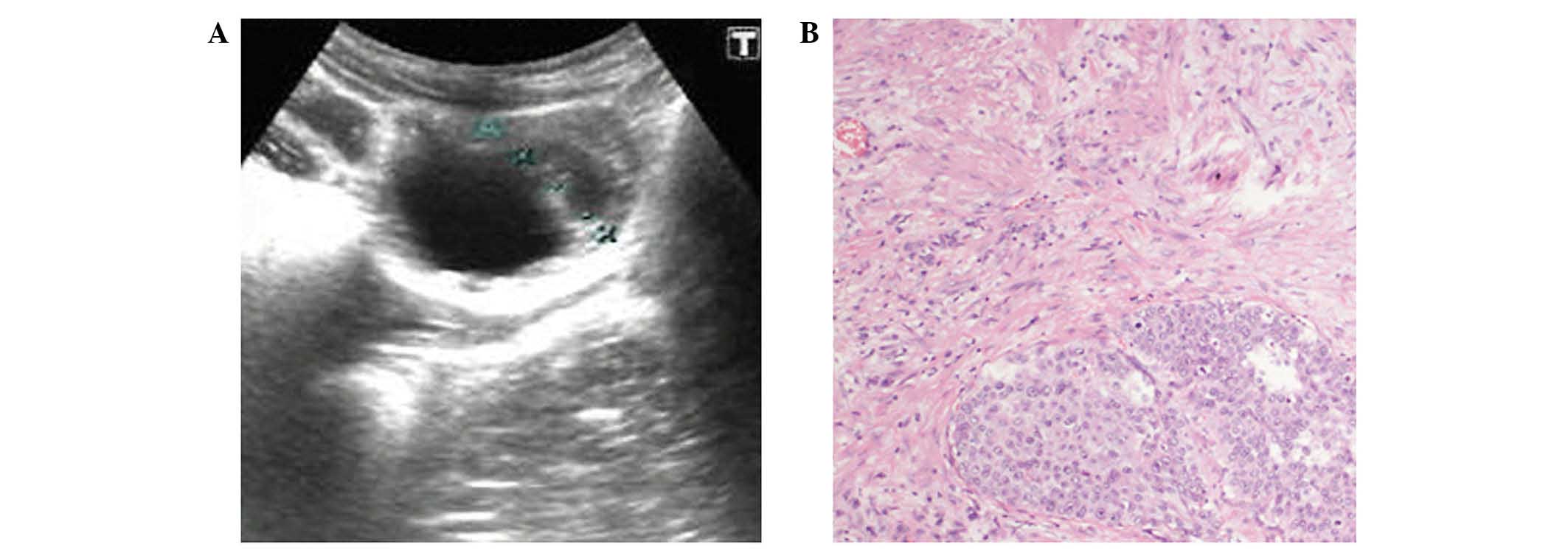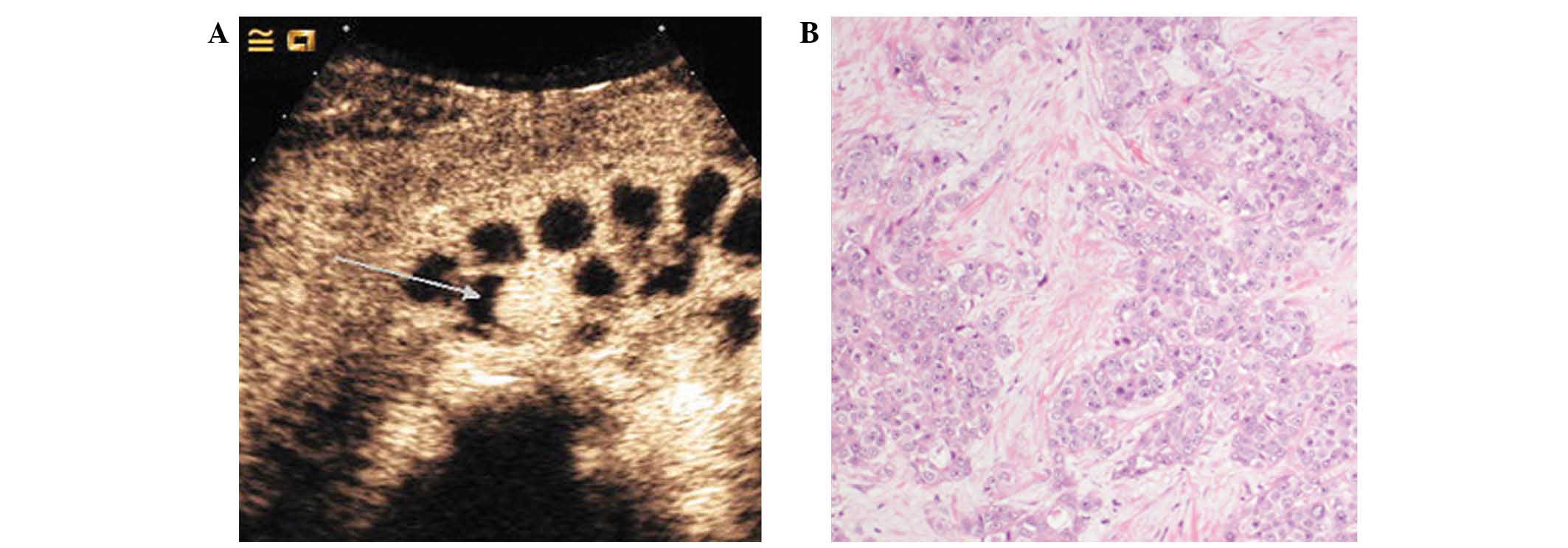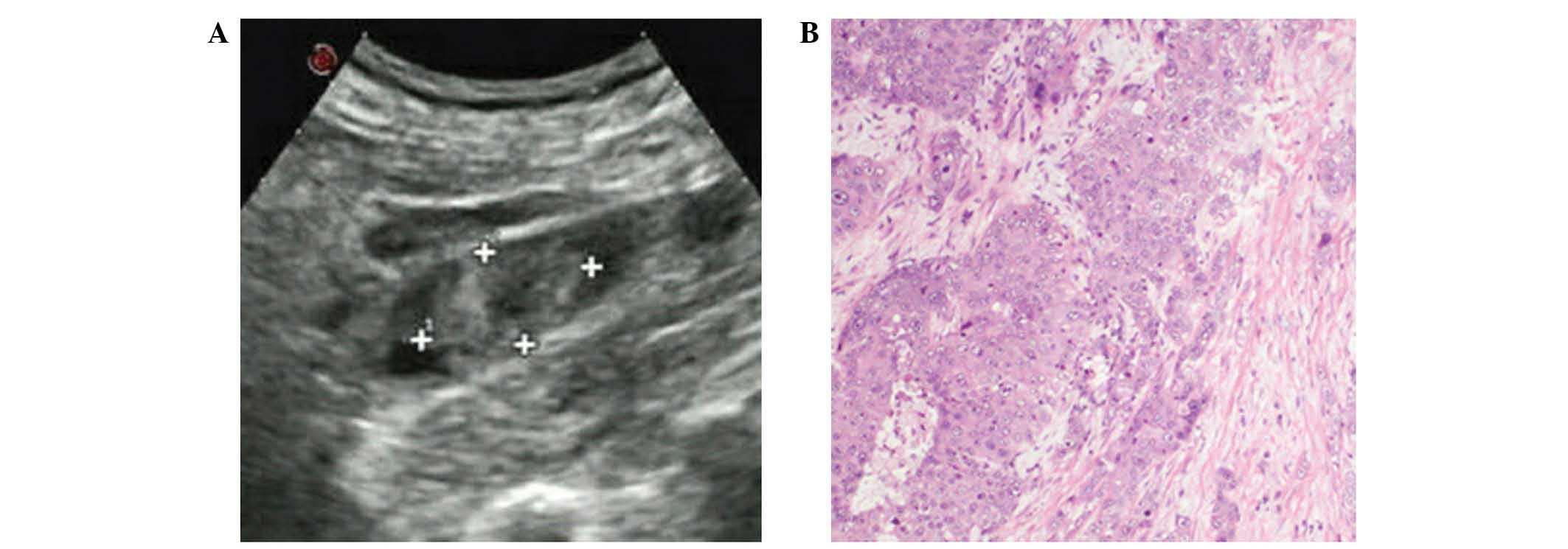Introduction
Increasing epidemiological data indicate a growing
relative risk of malignancy among patients with end-stage renal
disease (ESRD), including renal cell carcinoma (RCC), urothelial
carcinoma (UC), and thyroid and lung cancer (1). The predominant tumor in Western
countries is RCC, while it is UC in Asian countries (2). Clinically, UC is a multifocal malignant
disease located in the uroepithelium. Recent data demonstrate that
2–4% of patients with a bladder UC also present with an upper
urinary tract tumor (UUTT); the incidence of UUTT is 2–6% among
patients who undergo a radical cystectomy for UC (3). Higher recurrence rates and more
aggressive biological behavior of UC in dialysis-dependent patients
have been confirmed compared with individuals without ESRD
(2). Additionally, these cases of UC
are not easy to monitor in dialysis-dependent patients due to
oliguria or anuria, which may obscure the typical symptoms, such as
gross hematuria (4).
The current study presents a case of metachronous
bladder cancer and bilateral UUTT in a dialysis-dependent patient
who received total cystectomy and left and right urinary tract
exenteration surgeries within 18 months.
Case report
A 35-year-old woman with end-stage renal failure
owing to nephrotoxic drugs had been on dialysis for three years,
since October 2011, in The First Affiliated Hospital of Zhejiang
University School of Medicine (Hangzhou, China). The patient had
experienced gross hematuria for 1 year and had been diagnosed with
a bladder tumor by ultrasound (MyLab Twice; Esaote Group, Milano,
Italy) (Fig. 1A) and cystoscope 1
month previously. The mass was located in anterior wall and
measured 2.3×2.7 cm. Pathological analysis of a biopsy specimen was
conducted. Hematoxylin and eosin staining of the paraffin-embedded
section revealed that the tumor tissue exhibited cellular atypia
and nuclear abnormity, and karyokinesis could be easily observed.
Infiltrative growth of the malignant cells indicated aggressive
biological behavior. These findings suggested a highly malignant
lesion. Total cystectomy was performed following admission of the
patient to our hospital. The final pathological diagnosis was high
grade invasive UC accompanied by sarcomatoid carcinoma (Fig. 1B). The surgery was successful, and
there was no sign of recurrence on regular computed tomography
(Brilliance 64; Royal Dutch Philips Electronics, Ltd., Amsterdam,
Netherlands) postoperatively.
However, 6 months later, a 2.2-cm space-occupying
lesion in the right pelvis was detected by ultrasound (Fig. 2A), which was indicated to be a
malignant tumor. According to standard principles, a right urinary
tract exenteration was selected as curative treatment for the
patient, and high-grade invasive UC was subsequently confirmed by
pathologists (Fig. 2B).
Postoperatively, dialysis was continued for renal replacement
therapy (RRT).
After another 6 months, multiple left pelvis and
ureteral tumors were identified by ultrasound (Fig. 3A); the largest tumor was detected in
the pelvis and had a diameter of 3.5 cm. Left urinary tract
exenteration was performed as required. High-grade invasive UC was
eventually diagnosed (Fig. 3B). At
this point, the whole urinary tract of the patient had been removed
via three separate surgeries. Continuous dialysis was administered
without interruption during the surgeries. No recurrence was
detected in the patient for 6 months following the final surgery.
The patient was scheduled to receive regular follow-ups and
dialysis.
Informed consent for the present report was obtained
from the patient.
Discussion
In China, the variety of malignancies occurring
among the population of patients undergoing dialysis is distinct
from that in Western countries; the incidence of UC is more notable
than any other type of malignancy among Chinese ESRD patients
(2,4,5), whilst
renal cell carcinoma is more common in Western countries. The
reason for the high incidence and prevalence of UC in ESRD patients
in China is unknown; however, chronic bladder irritation, decreased
urinary washout effect, and atrophic involution of the bladder may
be contributing factors. In the current case, the patient received
dialysis for RRT, and experienced metachronous UC of the entire
urinary tract, which was similar to the results of the previous
studies (2,4,5). Surgical
excision is the preferred treatment in this circumstance.
Currently, maintenance dialysis is one of
predominant therapies for ESRD patients worldwide (1). However, the influence of dialysis on the
characteristics of UC in the RRT population remains uncertain.
Numerous studies have focussed on elucidating the association
between UC and dialysis (4,6–8). The
etiology of UC in patients undergoing RRT is multifactorial and
complex. Recent studies suggested that direct DNA damage by
immunosuppression is important in ESRD patients. The association
between UC and viral infection, however, remains a controversial
topic (6,7). On the other hand, drug-induced
immunosuppression following renal transplant, and chronic bladder
irritation due to anuria in ESRD patients, which decreases the
effect of urinary tract washing by urine flow, have been reported
to be predisposing factors for UC development (4). Additionally, epidemiological
investigations indicate that the factors involved in the
development of UC in RRT patients may include smoking, analgesic
nephropathy, arsenic poisoning, and uremia (8).
With regard to the treatment of UC, this may differ
between dialysis patients and the normal population; a more
aggressive approach may be selected for ESRD patients due to the
higher rate of recurrence and metachronous UC. Total urinary tract
exenteration may be an optional therapeutic strategy for this
specific population due to non-functional urinary tracts, but this
is not available for patients without ESRD. In the current case,
metachronous UC of whole urinary tract required three major
surgeries, which resulted in severe physiological and psychological
effects on the patient. As dialysis patients with UC have a higher
rate of recurrence and metachronous tumors than non-ESRD patients,
it is possible that total urinary tract exenteration may be a good
therapeutic option for this specific population. A recent study of
dialysis patients with UC reported that the 5-year survival rate of
patients undergoing radical cystectomy with concurrent
nephroureterectomy was better compared with that of patients who
did not undergo concurrent nephroureterectomy. The authors suggest
aggressive treatment in patients in a chronic stable condition to
improve survival rate (9). However, a
high mortality rate was noted in patients undergoing cystectomy
with concurrent nephroureterectomy due to various complications
(9,10). This topic remains in controversial.
For the high-risk, dialysis-dependent ESRD patient group, at least,
total urinary tract exenteration could be a good therapeutic option
due to the high incidence of tumors in the non-functioning upper
and lower urinary tract.
In summary, the current report presents a case of
metachronous UC of whole urinary tract in a dialysis-dependent
patient, which indicates the more aggressive features of UC in this
specific population. A surgical approach is the first choice for
these patients. Total urinary tract exenteration is an available
option; however, the status of the patient and the stage of the
renal disease should be considered prior to surgery.
Acknowledgements
The current study was supported by a grant from the
Scientific Research Fund of the Health Bureau of Zhejiang Province
(grant no. 2015KYA072).
References
|
1
|
Weng PH, Hung KY, Huang HL, Chen JH, Sung
PK and Huang KC: Cancer specific mortality in chronic kidney
disease: Longitudinal follow-up of a large cohort. Clin J Am Soc
Nephrol. 6:1121–1128. 2011. View Article : Google Scholar : PubMed/NCBI
|
|
2
|
Feng WW, Wang TN, Chen HC, Ho JC and Ko
YC: Malignancies after renal transplantation in southern Taiwan:
Experience in one centre. BJU Int. 99:825–829. 2007. View Article : Google Scholar : PubMed/NCBI
|
|
3
|
Izquierdo L, Truán D, Alvarez-Vijande R
and Alcaraz A: Large series of 114 cases with long term follow-up
of upper urinary tract urothelial tumors. Actas Urol Esp.
34:232–237. 2010.(In Spanish). View Article : Google Scholar : PubMed/NCBI
|
|
4
|
Ou JH, Pan CC, Lin JS, Tzai TS, Yang WH,
Chang CC, Cheng HL, Lin YM and Tong YC: Transitional cell carcinoma
in dialysis patients. Eur Urol. 37:90–94. 2000. View Article : Google Scholar : PubMed/NCBI
|
|
5
|
Wu MJ, Lian JD, Yang CR, Cheng CH, Chen
CH, Lee WC, Shu KH and Tang MJ: High cumulative incidence of
urinary tract transitional cell carcinoma after kidney
transplantation in Taiwan. Am J Kidney Dis. 43:1091–1097. 2004.
View Article : Google Scholar : PubMed/NCBI
|
|
6
|
Pino L, Rijo E, Nohales G, Frances A, Ubre
A and Arango O: Bladder transitional cell carcinoma and BK virus in
a young kidney transplant recipient. Transpl Infect Dis.
15:E25–E27. 2013. View Article : Google Scholar : PubMed/NCBI
|
|
7
|
Xiao J, Zhu X, Hao GY, Zhu YC, Ma LL,
Zhang YH and Tian Y: Association between urothelial carcinoma after
renal transplantation and infection by human papillomavirus types
16 and 18. Transplant Proc. 43:1638–1640. 2011. View Article : Google Scholar : PubMed/NCBI
|
|
8
|
Zhang B, Shen C, Han WK and Yu W:
Comparison of clinicopathologic characteristics of urothelial
carcinoma between patients after renal transplantation and on
dialysis. Transplantation. 98:552–556. 2014. View Article : Google Scholar : PubMed/NCBI
|
|
9
|
Tseng SF, Chuang YC and Yang WC: Long-term
outcome of radical cystectomy in ESDR patients with bladder
urothelial carcinoma. Int Urol Nephrol. 43:1067–1071. 2011.
View Article : Google Scholar : PubMed/NCBI
|
|
10
|
Wu CF, Shee JJ, Ho DR, Chen WC and Chen
CS: Different treatment strategies for end stage renal disease in
patients with transitional cell carcinoma. J Urol. 171:126–129.
2004. View Article : Google Scholar : PubMed/NCBI
|

















